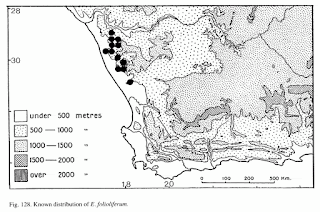71. Eriospermum folioliferum Andrews, Bot. Rep. t.521 (1808); Schultes & Schultes Syst. Veg. 7(1): 505 (1829); Duthie, Ann. Univ. Stellenb. 18(A2): 36 (1940); non Ker-Gawl., Bot Mag. t. 1382 (1811 ); Lindl., Edwards Bot. Re g. t. 795 (1824 ). Type: South Africa, Cape of Good Hope, Cult. in London, Fig. in Bot. Rep. t. 521 (lectotype).
Phylloglottis foliolifera (Andrews) Salisb. Gen. Pl. 15 (1866).
Plants with hysteranthous leaves, solitary, inflorescence up to 400 mm high.
Tuber pyriform, becoming irregular in shape with age, up to 50 mm long, 40 mm wide, skin light brown, interior dark red; growing point basal to lateral.
Old leaf sheaths up to 100 mm long, membranous to fibrous, dark brown.
Leaf solitary, erect: contemporary leaf sheath exserted up to 40 mm, white, flushed red towards the lamina: lamina held horizontally, ovate-cordate, acute, apex retrorse, up to 60 mm long, 40 mm wide; abaxial surface whitish flushed red, glabrous; adaxial surface green, producing up to 50 flat, unbranched, slightly twisted enations, each up to 90 mm long and 5 mm wide, all covered with white trichomes; enations more closely packed near the leaf sheath and absent from the apex.
Peduncular bract seldom exserted above ground, non-sheathing part up to 4 mm long, brown, membranous.
Peduncle up to 280 mm long, 1 mm diameter, reddish-green at the base becoming green above.
Raceme variable, subspicate or lax, up to 140 mm long, 10 mm wide, with up to 22 flowers.
Bracts narrowly trianguiar, 1 mm long, membranous with a dark brown midnerve.
Pedicels may all be only 2 mm long or lowest up to 10 mm long, erecto-patent.
Flowers campanulate to spreading forming a triangular outline when fully opened, about 12 mm diameter.
Tepals dimorphic, white with a green midnerve, flecked with red; outer tepals spreading, elliptic, 4.5 mm long and 2 mm wide, inner erect, spathulate with crimped and fimbriate apex, nearly 4 mm long and 2 mm at the widest part.
Filaments dimorphic, bright tomato red or white. flecked red; outer ovate. about 2 mm long and 1.3 mm wide, the inner broadly triangular, 1.8 mm long and less than 1 mm wide at the base.
Ovary globose to ovoid, 1.5 mm long and wide, yellowish-green, sometimes with dark maroon stippling.
Style cylindrical, 1.5 mm long, white.
Flowering time: December to January.
Leafing period: April to September.
Distribution and habitat: Centred in northern Namaqualand E.folioliferum exists as far south as Nuwerus. It grows mainly on stony, well-drained ground (Figure 128).
Diagnostic features: E.folioliferum is a very distinctive species in the vegetative stage with its ovate leaf producing numerous flat, unbranched enations covered with white hairs (Figure 129).
An article by Troll (1938) includes an illustration of a plant named by Marloth as E.verrucosum with the number Marloth 13726. This is a manuscript name and the specimen is clearly E.folioliferum.
Reference: Pauline L. Perry, A REVISION OF THE GENUS
ERIOSPERMUM (Eriospermaceae)


No comments:
Post a Comment